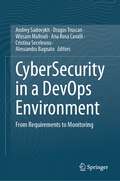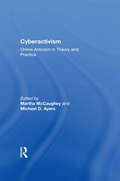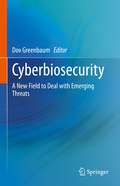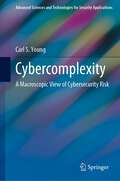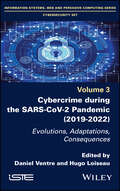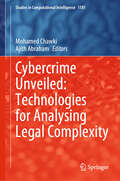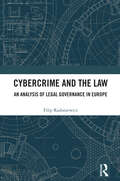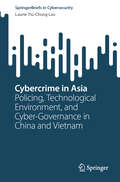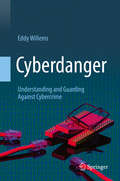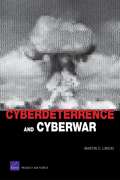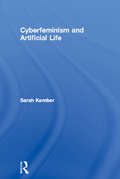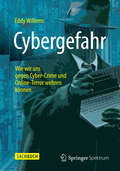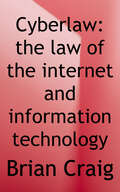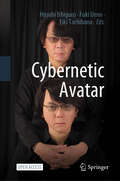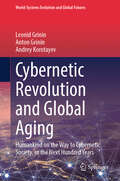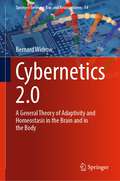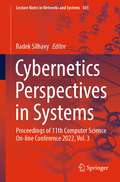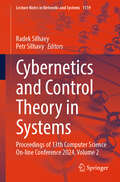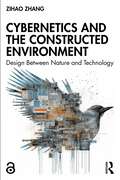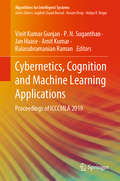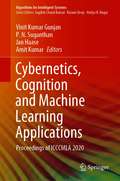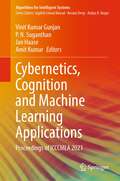- Table View
- List View
CyberPhysical Systems: Decision Making Mechanisms and Applications (River Publishers Series In Circuits And Systems Is A Series Of Comprehensive Academic And Professional Books Which Focus On Theory And Applications Of Circuit And Systems. This Includes Analog And Digital Integrated Circuits, Memory Technologies, System-on-chip And Processor Design. The Series Also Includes Books On Electronic Design Automation And Design Methodology, As Well As Computer Aided Des)
by Dimitrios Soudris Kostas Siozios Elias KosmatopoulosAs systems continue to evolve they rely less on human decision-making and more on computational intelligence. This trend in conjunction to the available technologies for providing advanced sensing, measurement, process control, and communication lead towards the new field of Cyber-Physical System (CPS). Cyber-physical systems are expected to play a major role in the design and development of future engineering platforms with new capabilities that far exceed today’s levels of autonomy, functionality and usability. Although these systems exhibit remarkable characteristics, their design and implementation is a challenging issue, as numerous (heterogeneous) components and services have to be appropriately modeled and simulated together. The problem of designing efficient CPS becomes far more challenging in case the target system has to meet also real-time constraints.CyberPhysical Systems: Decision Making Mechanisms and Applications describes essential theory, recent research and large-scale usecases that addresses urgent challenges in CPS architectures. In particular, it includes chapters on:• Decision making for large scale CPS• Modeling of CPS with emphasis at the control mechanisms• Hardware/software implementation of the control mechanisms• Fault-tolerant and reliability issues for the control mechanisms• Cyberphysical user-cases that incorporate challenging decision making
CyberSecurity in a DevOps Environment: From Requirements to Monitoring
by Cristina Seceleanu Ana Rosa Cavalli Andrey Sadovykh Dragos Truscan Wissam Mallouli Alessandra BagnatoThis book provides an overview of software security analysis in a DevOps cycle including requirements formalisation, verification and continuous monitoring. It presents an overview of the latest techniques and tools that help engineers and developers verify the security requirements of large-scale industrial systems and explains novel methods that enable a faster feedback loop for verifying security-related activities, which rely on techniques such as automated testing, model checking, static analysis, runtime monitoring, and formal methods. The book consists of three parts, each covering a different aspect of security engineering in the DevOps context. The first part, "Security Requirements", explains how to specify and analyse security issues in a formal way. The second part, "Prevention at Development Time", offers a practical and industrial perspective on how to design, develop and verify secure applications. The third part, "Protection at Operations", eventually introduces tools for continuous monitoring of security events and incidents. Overall, it covers several advanced topics related to security verification, such as optimizing security verification activities, automatically creating verifiable specifications from security requirements and vulnerabilities, and using these security specifications to verify security properties against design specifications and generate artifacts such as tests or monitors that can be used later in the DevOps process. The book aims at computer engineers in general and does not require specific knowledge. In particular, it is intended for software architects, developers, testers, security professionals, and tool providers, who want to define, build, test, and verify secure applications, Web services, and industrial systems.
Cyberactivism: Online Activism in Theory and Practice (Routledge Studies In New Media And Cyberculture Ser.)
by Martha McCaughey Michael D. AyersCyberactivism is a timely collection of essays examining the growing importance of online activism. The contributors show how online activists have not only incorporated recent technology as a tool for change, but also how they have changed the meaning of activism, what community means, and how they conceive of collective identity and democratic change. Topics addressed range from the Zapatista movement's use of the web to promote their cause globally to the establishment of alternative media sources like indymedia.org to the direct action of "hacktivists" who disrupt commercial computer networks. Cyberactivism is essential reading for anyone interested in understanding the impact of the Internet on politics today.
Cyberbiosecurity: A New Field to Deal with Emerging Threats
by Dov GreenbaumBiocybersecurity applies cybersecurity research to the field of biology, and, to a lesser degree, applies biological principles to the field of cybersecurity. As biologists increasingly research, collaborate, and conduct research online, biocybersecurity has become crucial to protect against cyber threats. This book provides an overview of biocybersecurity through the lens of researchers in academia, industry professionals, and government, in both biology and cybersecurity fields. The book highlights emerging technologies, and identifies emerging threats connected with these technologies, while also providing a discussion of the legal implications involved.This book takes on a multidisciplinary approach, and appeals to both professionals and researchers in the synthetic biology, bioinformatics, and cybersecurity fields.
Cybercomplexity: A Macroscopic View of Cybersecurity Risk (Advanced Sciences and Technologies for Security Applications)
by Carl S. YoungThis book tackles the problem of complexity within IT environments, i.e., "Cybercomplexity," which is generally recognized as a principal source of cybersecurity risk. The book first defines complexity and simplifies its analysis by assuming a probabilistic approach to security risk management. It then proposes a simple model of cybercomplexity that is based on Shannon entropy, a basic concept in information theory. The key drivers of cybercomplexity emerge from this model, where these drivers reveal the scale-dependence of cybersecurity risk and explain why macroscopic security controls are required to address cybersecurity risk on an enterprise scale. The significant operational implications of cybercomplexity are also discussed, thereby providing both a theoretical framework and a practical guide to addressing this longstanding problem in cybersecurity risk management.
Cybercrime During the SARS-CoV-2 Pandemic: Evolutions, Adaptations, Consequences
by Daniel Ventre Hugo LoiseauThe SARS-CoV-2 pandemic has had an undeniable impact on cybercrime. The initial crisis quickly became a global catastrophe with multiple consequences in economics, health, and political and social fields. This book explores how this global emergency has influenced cybercrime. Indeed, since feeding off new vulnerabilities, thanks to the effects of the pandemic crisis in various states around the world, cybercrime has increased and evolved.In 2020, the world was already dealing with numerous tensions and the effects of the global crisis have therefore only tended to exacerbate the issues that relate to cybercrime. For example, radicalization and identity theft has found an environment in which they thrive: the Internet. Criminals have been able to adapt their modus operandi, their targets and their attack vectors. However, on the plus side, the response of law enforcement and public authorities, in terms of the legal, policing and policy side of cybercrime, has also been adapted in order to better combat the increase in this phenomenon.
Cybercrime Unveiled: Technologies for Analysing Legal Complexity (Studies in Computational Intelligence #1181)
by Ajith Abraham Mohamed ChawkiThe book offers a comprehensive examination of the ever-evolving landscape of cybercrime. Bringing together experts from various legal and technical backgrounds, this book presents an integrated approach to understanding the complexities of cyber threats. It explores various topics, from social engineering and AI-enhanced cybercrime to international cybersecurity governance and the Dark Web’s role in money laundering. By offering theoretical insights and practical case studies, the book is a vital resource for policymakers, cybersecurity professionals, legal experts, and academics seeking to grasp the intricacies of cybercrime. This book includes 15 rigorously selected chapters from 31 submissions, chosen through a double-blind peer review by an international panel of referees. Each chapter delves into a unique aspect of cybercrime, from the role of AI in modern cyber threats to the emerging legal challenges posed by global cybersecurity norms. Contributors from around the world provide diverse perspectives, making this book a global reference on the topic of cybercrime and digital security. As cybercrime continues to grow in both complexity and impact, this book highlights the critical importance of collaboration between legal and technical experts. By addressing the key challenges posed by cyber threats, whether through AI, cryptocurrency, or state sovereignty—this book provides readers with actionable insights and strategies to tackle the most pressing issues in the digital age.
Cybercrime and the Law: An Analysis of Legal Governance in Europe
by Filip RadoniewiczThis book provides a comprehensive and synthetic analysis of the legal acts of the Council of Europe and the European Union affecting regulation of cybercrime in EU countries. Technical aspects relating to cybercrime are also discussed. The work explains core ideas, including background, nomenclature, a definition of computer crime and a history of its criminalisation. It examines the Council of Europe’s Convention on Cybercrime, the first international law act governing the subject, and the additional Protocol to the Convention on Cybercrime, dealing with the criminalisation of computer-generated racist and xenophobic acts. The volume discusses European Union regulations, including applicable European Union laws on cybercrime such as the Council Framework Decision 2005/222/JHA and Directive 2013/40/EU on attacks against information systems, and Directive 2011/93/EU on Combating the Sexual Abuse and Sexual Exploitation of Children and Child Pornography. Finally, the work explores issues of cyberterrorism including the dissemination of terrorist content online. The book will be a valuable resource for academics, researchers and policy-makers working in the areas of criminal law, IT law, EU law and cyber security.
Cybercrime in Asia: Policing, Technological Environment, and Cyber-Governance in China and Vietnam (SpringerBriefs in Cybersecurity)
by Laurie Yiu-Chung LauThis work examines the most pressing and contentious issues in cybercrime currently facing the China and Vietnam, and how best to tackle them. The text sets the context for how blocs of nations (including the least ready, the most ready, and those occupying a central position in terms of cybercrime readiness) react to the evolving challenges of cybercrime, with a focus on prevention and control. In this way, the work discusses why certain blocs of nations in the Asia-Pacific region are not at an optimal level of cybercrime readiness despite the rapid pace of technological advancement in this region, and how such nations can become regional leaders in cybercrime readiness.
Cyberdanger: Understanding and Guarding Against Cybercrime
by Eddy WillemsThis book describes the key cybercrime threats facing individuals, businesses, and organizations in our online world. The author first explains malware and its origins; he describes the extensive underground economy and the various attacks that cybercriminals have developed, including malware, spam, and hacking; he offers constructive advice on countermeasures for individuals and organizations; and he discusses the related topics of cyberespionage, cyberwarfare, hacktivism, and anti-malware organizations, and appropriate roles for the state and the media. The author has worked in the security industry for decades, and he brings a wealth of experience and expertise. In particular he offers insights about the human factor, the people involved on both sides and their styles and motivations. He writes in an accessible, often humorous way about real-world cases in industry, and his collaborations with police and government agencies worldwide, and the text features interviews with leading industry experts. The book is important reading for all professionals engaged with securing information, people, and enterprises. It’s also a valuable introduction for the general reader who wants to learn about cybersecurity.
Cyberdeterrence and Cyberwar
by Martin C. LibickiCyberspace, where information--and hence serious value--is stored and manipulated, is a tempting target. An attacker could be a person, group, or state and may disrupt or corrupt the systems from which cyberspace is built. When states are involved, it is tempting to compare fights to warfare, but there are important differences. The author addresses these differences and ways the United States protect itself in the face of attack.
Cyberfeminism and Artificial Life
by Sarah KemberCyberfeminism and Artificial Life examines the construction, manipulation and re-definition of life in contemporary technoscientific culture. It takes a critical political view of the concept of life as information, tracing this through the new biology and the discourse of genomics as well as through the changing discipline of artificial life and its manifestation in art, language, literature, commerce and entertainment. From cloning to computer games, and incorporating an analysis of hardware, software and 'wetware', Sarah Kember extends current understanding by demonstrating the ways in which this relatively marginal field connects with, and connects up global networks of information systems.Ultimately, this book aims to re-focus concern on the ethics rather than on the 'nature' of life-as-it-could-be.
Cybergefahr: Wie wir uns gegen Cyber-Crime und Online-Terror wehren können
by Eddy WillemsMan kann online wählen, Rechnungen bezahlen und Tickets kaufen - aber wie sicher ist das? Überall lauern Viren, Spam, Hackerangriffe und sogar Cyber-Spione. Wie kann man sich schützen und wie sollte man dem Phänomen Cyber-Crime begegnen? Der bekannte Security-Experte Eddy Willems gibt einen Überblick über Online-Gefahren und Möglichkeiten, sich vor ihnen zu schützen. Er erläutert spannend die Vergangenheit, Gegenwart und Zukunft des Cyber-Crime.
Cyberia (Cyberia #1)
by Chris LynchZane lives in a completely wired world where every pet has a microchip that allows it to talk. Zane soon learns that the pets aren't actually saying what the chip is translating. They aren't happy that all animals have been domesticated, and they enlist Zane to help them fight back and ensure their freedom.
Cyberlaw: The Law of the Internet and Information Technology
by Brian CraigFeaturing the most current exploration of cyberlaw, this book helps students understand the legal and policy issues associated with the Internet. Tackling a full range of legal topics, it includes discussion of jurisdiction, intellectual property, contracts, taxation, torts, computer crimes, online speech, defamation and privacy. <p><p>Chapters include recent, relevant cases, discussion questions and exercises at the end of each chapter. Using a consistent voice and clear explanations, the author covers the latest developments in cyberlaw-from cases to legislation to regulations.
Cybernetic Avatar
by Hiroshi Ishiguro Fuki Ueno Eiki TachibanaThis open access book presents a vision of a future, where avatars play an integral role in shaping the fabric of our interconnected society. The book introduces the authors’ ongoing efforts to advance avatar technologies and is structured into nine chapters. Chapter 1 discusses the potentially revolutionary impact of cybernetic avatars (CAs) as a new medium of communication, liberating individuals from physical barriers and creating more flexible work environments. Chapters 2, 3, and 4 present developments in CAs with advanced autonomous functionality. Chapters 5 and 6 discuss the creation of a CA platform that connects multiple operators and CAs. Chapter 7 explores the physiological and neuroscientific effects of avatars and other media on operators and users. Finally, Chapters 8 and 9 discuss the societal implementation of CAs. This book is stemmed from one of the Moonshot R&D projects funded by the Japan Science and Technology Agency (JST).
Cybernetic Modeling for Bioreaction Engineering (Cambridge Series in Chemical Engineering)
by Doraiswami Ramkrishna Hyun-Seob SongUniquely focusing on dynamic modeling, this volume incorporates metabolic regulation as a survival mechanism for cells, by driving metabolism through optimal investment of its resources for control of enzyme synthesis and activity. Consequently, the models have a proven record of describing various uptake patterns of mixed carbon substrates that have become significant in modern applications of biomass for the production of bioenergy. The models accurately describe dynamic behavior of microbes in nutrient environments with mixtures of complementary substrates, such as carbon and nitrogen. Modeling of large metabolic networks (including prospects for extension to genome scale) is enabled by lumped hybrid cybernetic models with an unparalleled capacity to predict dynamic behavior of knockout strains. This is an invaluable, must-have reference for bio-researchers and practicing engineers.
Cybernetic Revolution and Global Aging: Humankind on the Way to Cybernetic Society, or the Next Hundred Years (World-Systems Evolution and Global Futures)
by Leonid Grinin Andrey Korotayev Anton GrininThis book explores the global technological transformations that have shaped development of society for eons, from the emergence of Homo sapiens to the modern day. Looking at a potential future for all of this century and the beginning of the next, the book explores how society is changing as a result of the two most powerful trends: technological advances and global aging. It studies the forthcoming technological wave – the Cybernetic Revolution, which will encompass AI, medical technology and biotechnology, robotics, cognitive, nanotechnology etc. In turn, it shows why and how global aging will become one of the most powerful factors, influencing the evolution of society and the World System as a whole. Lastly, the book demonstrates how technological innovations can change the way people live and the society of the future, assessing both the new opportunities and threats posed by uncontrolled technological progress. Accordingly, it will appeal to social scientists, political scientists, economists and historians who are interested in technological transformations and their social and economic impacts.
Cybernetics 2.0: A General Theory of Adaptivity and Homeostasis in the Brain and in the Body (Springer Series on Bio- and Neurosystems #14)
by Bernard WidrowThis book takes the notions of adaptivity and learning from the realm of engineering into the realm of biology and natural processes. It introduces a Hebbian-LMS algorithm, an integration of unsupervised Hebbian learning and supervised LMS learning in neural networks, as a mathematical representation of a general theory for synaptic learning in the brain, and adaptation and functional control of homeostasis in living systems. Written in a language that is able to address students and scientists with different backgrounds, this book accompanies readers on a unique journey through various homeostatic processes in living organisms, such as body temperature control and synaptic plasticity, explaining how the Hebbian-LMS algorithm can help understand them, and suggesting some open questions for future research. It also analyses cell signalling pathways from an unusual perspective, where hormones and hormone receptors are shown to be regulated via the principles of the Hebbian-LMS algorithm. It further discusses addiction and pain, and various kinds of mood disorders alike, showing how they can be modelled with the Hebbian-LMS algorithm. For the first time, the Hebbian-LMS algorithm, which has been derived from a combination of Hebbian theory from the neuroscience field and the LMS algorithm from the engineering field of adaptive signal processing, becomes a potent model for understanding how biological regulation works. Thus, this book is breaking new ground in neuroscience by providing scientists with a general theory for how nature does control synaptic learning. It then goes beyond that, showing that the same principles apply to hormone-mediated regulation of physiological processes. In turn, the book tackles in more depth the concept of learning. It covers computer simulations and strategies for training neural networks with the Hebbian-LMS algorithm, demonstrating that the resulting algorithms are able to identify relationships between unknown input patterns. It shows how this can translate in useful ideas to understand human memory and design cognitive structures. All in all, this book offers an absolutely, unique, inspiring reading for biologists, physiologists, and engineers, paving the way for future studies on what we could call the nature’s secret learning algorithm.
Cybernetics Perspectives in Systems: Proceedings of 11th Computer Science On-line Conference 2022, Vol. 3 (Lecture Notes in Networks and Systems #503)
by Radek SilhavyThis book contains the refereed proceedings of the Cybernetics Perspectives in Systems session of the 11th Computer Science On-line Conference 2022 (CSOC 2022), which was held in April 2022 online. Papers on modern cybernetics and informatics in the context of networks and systems are an important component of current research issues. This volume contains an overview of recent method, algorithms and designs.
Cybernetics and Control Theory in Systems: Proceedings of 13th Computer Science On-line Conference 2024, Volume 2 (Lecture Notes in Networks and Systems #1119)
by Radek Silhavy Petr SilhavyAddressing key issues in modern cybernetics and informatics, this book presents vital research within networks and systems. It offers an extensive overview of the latest methods, algorithms, and design innovations. This book compiles the meticulously reviewed proceedings of the Networks and Systems in Cybernetics session of the 13th Computer Science Online Conference 2024 (CSOC 2024), held virtually in April 2024.
Cybernetics and the Constructed Environment: Design Between Nature and Technology
by Zihao ZhangGrounded in contemporary landscape architecture theory and practice, Cybernetics and the Constructed Environment blends examples from art, design, and engineering with concepts from cybernetics and posthumanism, offering a transdisciplinary examination of the ramifications of cybernetics on the constructed environment. Cybernetics, or the study of communication and control in animals and machines, has grown increasingly relevant nearly 80 years after its inception. Cyber-physical systems, sensing networks, and spatial computing—algorithms and intelligent machines—create endless feedback loops with human and non-human actors, co-producing a cybernetic environment. Yet, when an ecosystem is meticulously managed by intelligent machines, can we still call it wild nature? Posthumanism ideas, such as new materialism, actor-network theory, and object-oriented ontology, have become increasingly popular among design disciplines, including landscape architecture, and may have provided transformative frameworks to understand this entangled reality. However, design still entails a sense of intentionality and an urge to control. How do we, then, address the tension between the designer’s intentionality and the co-produced reality of more-than-human agents in the cybernetic environment? Is posthumanism enough to develop a framework to think beyond our all-too-human ways of thinking? For researchers, scholars, practitioners, and students in environmental design and engineering disciplines, this book maps out a paradigm of environmentalism and ecological design rooted in non-communication and uncontrollability, and puts a speculative turn on cybernetics.Chapters 8 and 9 of this book are freely available as a downloadable Open Access PDF at http://www.taylorfrancis.com under a Creative Commons Attribution-Non Commercial-No Derivatives (CC-BY-NC-ND) 4.0 license.
Cybernetics, Cognition and Machine Learning Applications: Proceedings of ICCCMLA 2019 (Algorithms for Intelligent Systems)
by Amit Kumar Vinit Kumar Gunjan Jan Haase Balasubramanian Raman P. N. SuganthanThis book provides a collection of selected papers presented at the International Conference on Cybernetics, Cognition and Machine Learning Applications (ICCCMLA 2019), which was held in Goa, India, on 16–17 August 2019. It covers the latest research trends and advances in the areas of data science, artificial intelligence, neural networks, cognitive science and machine learning applications, cyber-physical systems, and cybernetics.
Cybernetics, Cognition and Machine Learning Applications: Proceedings of ICCCMLA 2020 (Algorithms for Intelligent Systems)
by Amit Kumar Vinit Kumar Gunjan Jan Haase P. N. SuganthanThis book includes the original, peer reviewed research articles from the 2nd International Conference on Cybernetics, Cognition and Machine Learning Applications (ICCCMLA 2020), held in August, 2020 at Goa, India. It covers the latest research trends or developments in areas of data science, artificial intelligence, neural networks, cognitive science and machine learning applications, cyber physical systems and cybernetics.
Cybernetics, Cognition and Machine Learning Applications: Proceedings of ICCCMLA 2021 (Algorithms for Intelligent Systems)
by Amit Kumar Vinit Kumar Gunjan Jan Haase P. N. SuganthanThis book includes the original, peer-reviewed research articles from the 3rd International Conference on Cybernetics, Cognition and Machine Learning Applications (ICCCMLA 2021), held in August 21 – 22, 2021, at Goa, India. It covers the latest research trends or developments in areas of data science, artificial intelligence, neural networks, cognitive science and machine learning applications, cyber physical systems and cybernetics.

